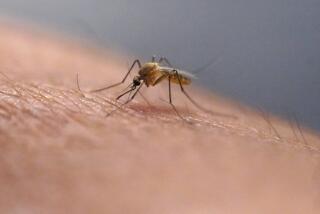Dengue Fever Alert
- Share via
With a dengue fever epidemic spreading through Central America, Mexico and the Caribbean, travelers to these destinations are being urged to take precautions.
Since the beginning of this year, more than 35,000 cases of dengue fever and 545 cases of its more severe form--hemorrhagic dengue--have been reported in Central America, Mexico and the Caribbean. It has left 24 dead, according to the Pan American Health Organization (PAHO), an arm of the World Health Organization that works to eradicate disease and promote cooperation among governments to solve health problems.
Those who are stricken do not fall ill immediately. The incubation period lasts from three to 15 days, making it possible for a traveler to return home before experiencing symptoms. Those who succumb to the milder form of the disease--actually four similar viruses--generally recover completely in several weeks. But those who contract the most serious form of the disease may die.
The current epidemic began in 1994, according to PAHO spokesman Dan Epstein. But dengue fever “has been undergoing a resurgence in this hemisphere and has been picking up speed,” said Dr. James H. Runnels of Baylor University’s Travel Medicine Service.
Last month, a Texas woman who traveled from McAllen, Tex., about 12 miles across the border to Reynosa, Mexico, contracted dengue.
And in Mexico, more than 2,500 dengue fever cases, including 45 cases of hemorrhagic dengue, have been reported so far this year, according to PAHO. In El Salvador, nearly 9,000 cases have been reported; in Nicaragua, more than 8,500; in the Honduras, nearly 8,000 cases; in Guatemala, more than 2,500; in Panama, nearly 1,500.
“The risk is low to travelers, but people should take it seriously,” said Dr. Terri Rock, a Santa Monica family practice physician who often provides travel medicine services. Simple precautions are universally urged.
Transmitted by the bite of an infected aedes mosquito present in Central and South America and the Caribbean, dengue fever is marked by sudden onset of symptoms including high fever, headache, joint and muscle pain, nausea and vomiting. The nickname “breakbone fever” reflects the intense joint pain that is symptomatic of the disease. Fever can subside and return unexpectedly.
People often write it off as simple flu, Rock said. Three to five days after the onset of fever, there can be a rash, originating on the torso but spreading to the arms, legs and face.
The milder form of dengue fever is usually benign. There is no vaccine and no specific treatment for the infection. Rest and medicine for symptom relief are the typical treatments, Runnels said.
Some patients, most often children, contract a more severe form of the disease called dengue hemorrhagic fever, in which severe blood vessel damage occurs and death may result. However, this form of the disease is much rarer: Only two out of the 1,500 cases in Panama this year were hemorrhagic.
In late September, at an emergency conference co-sponsored by the PAHO, representatives from 10 countries discussed how to stem the epidemic. Experts blame resurgence of the disease on setbacks in mosquito abatement programs, population shifts and growth. In 1995, according to the PAHO, the geographic distribution of the aedes mosquito is similar to its distribution before the successful abatement programs of the 1950s and ‘60s.
On an individual basis, there is much a traveler can do to decrease risk.
Avoidance is the best course. “Take some repellent,” Dan Epstein said. “Avoid forested areas at dusk or dawn [considered peak biting times]. Avoid stagnant pools of water.”
Use of bed nets and indoor aerosol insecticide in potentially hazardous areas is advised by the federal Centers for Disease Control and Prevention.
“Heed mosquito precautions day and night,” Rock said. “Not just in rural areas, and not just after dusk.” She also recommends use of permethrin spray for clothing.
“Spray clothes well, before you go,” Rock said. “It doesn’t harm clothing.”
Use repellents containing DEET (diethyltoluamide), Rock said. When choosing repellents, look for a product that bears a U.S. EPA-approved label and registration number, said Veda Federighi, spokeswoman for the Department of Pesticide Regulation of the state EPA. Don’t apply repellent to broken skin; follow label directions.
Avoid wearing black clothing, Rock said, because it can attract mosquitoes. “Wear light-colored, safari-type clothing,” she said, and avoid wearing shiny jewelry or using scented soaps and perfumes that might attract mosquitoes.
Travelers who contract a fever after returning home from epidemic areas should consult their physician, Rock said, even if it is the middle of flu season.
The Healthy Traveler appears the second and fourth week of every month.
More to Read
Sign up for Essential California
The most important California stories and recommendations in your inbox every morning.
You may occasionally receive promotional content from the Los Angeles Times.













